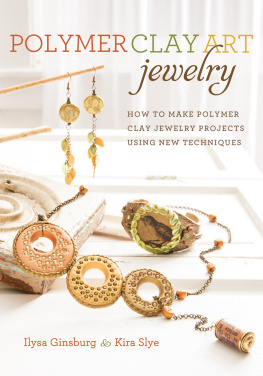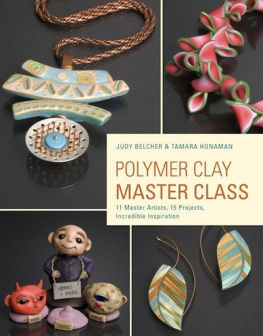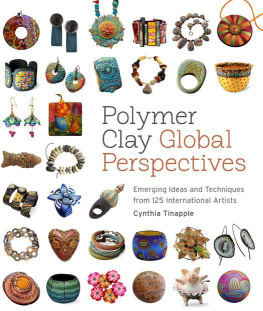2011 Yonat Dascalu - All rights reserved. this book may not be reproduced in any part or in whole by electronic means or otherwise without written permission of the author. eBook ISBN: 978-1-62110-045-4 Index: Polymer clay is a versatile, synthetic modeling material. It is made of PVC (Polyvinyl Chloride) particles and pigments which are bound together by a plasticizer. It is available in a wide variety of colors, which can be mixed together to create more beautiful shades. Polymer clay is non toxic, and can be baked and hardened in a home oven.
The possibilities of creating with polymer clay are practically endless! This book will guide you through the very basic stages of working with polymer clay, up to the more advanced methods and techniques. Each technique will be demonstrated with a step by step unique project. You will learn how to create designed clay sheets, a skinner blend, and how to make polymer clay canes: a technique called Millefiori. Millefiori means, one thousand flowers, this technique is used in Venetian glass work, and can be applied to polymer clay. It is a magical process of creating a two dimensional image in polymer clay, this image is kept throughout the cane, even after reducing it. When slicing the cane, each slice will still have the same image.
In this book you will learn how to use your cane slices and designed clay sheets to make beautiful beaded jewelry, cover glass objects, and create a variety of home decorations. You can contact me at my email address and Ill be happy to answer any of your questions. E-mail address: polymer.clay.book@gmail.com I wish you a lot of fun and inspiration in creating with polymer clay. Thank you, Yonat.  Yonat Dascalu Polymer clay artist. - Make sure to wash your hands after working with polymer clay. - When using a sharp blade, mark the blunt edge with a sticker so you always know which way to hold the knife/blade. - When working with young children, slicing canes should be supervised by an adult. - When working with young children, slicing canes should be supervised by an adult.
Yonat Dascalu Polymer clay artist. - Make sure to wash your hands after working with polymer clay. - When using a sharp blade, mark the blunt edge with a sticker so you always know which way to hold the knife/blade. - When working with young children, slicing canes should be supervised by an adult. - When working with young children, slicing canes should be supervised by an adult.
Polymer clay should be baked in a toaster oven or a conventional oven, never use a microwave! It is important to watch your oven temperature, if you bake in a temperature that is higher then what is recommended on the package, the clay might burn and release toxic fumes. Work Surface Its advisable to use a nonporous surface such as marble, formica, plastic placemats, glass, or a ceramic tile. Working with a ceramic tile has the advantage of not having to move your project from your work surface to the oven, you can put your project directly on the tile and into the oven. This works best when you have delicate or fragile projects to bake. Tools There is no need for any special tools to start withjust a work surface, craft knife, or a utility knife, and a rolling pin will do just fine. Later you can upgrade your tools and invest in specialized tools such as tissue blades, acrylic roller and a pasta machine, which saves a lot of time when conditioning the clay, mixing colors, and preparing sheets for making millefiori canes.
It is important to note that some of the plastic disposable dishes and plastic tools, such as cutters and plastic boxes, might cause an unwanted chemical reaction when used with the polymer clay. Therefore, they should be thoroughly cleaned after each use. Preparing the polymer clay for work. The clay must be well conditioned before you start working with it. If the clay crumbles, it means its not yet ready to work with. The clay is ready for work when it is warm and playable on your hands.
If you encounter an old or hard block of clay, cut it into small pieces and condition each piece separately, then combine all pieces into one big lump. If you have two packages of the same color of clay, and one is hard and the other is soft, you can mix the two packages together, and by doing so the soft package will soften the hard one. You can also condition the clay using a pasta machine, if the sheet of clay cracks on the crease when folded, it means you must continue passing it through the pasta machine. The clay is adequately conditioned when you can fold it without cracking. Note: when you build millefiori canes, please make sure all the colors you use are well conditioned, and have the same level of consistency - Different levels of consistency might cause distortion when reducing the cane. Working with different colors.
When using a number of colors, its best to begin with the lighter colors. Clean your hands before continuing with the next color. Baby wipes are very effective when cleaning clay from hands and work surfaces, and paper towels are good for drying. Baking tips. Always follow the manufacturers instructions for baking time and temperature, Insufficient baking time will result in weak, brittle pieces. High temperature might result in burning your work.
Let the clay cool before handling, the clay is slightly soft while warm and is fragile in this state. Save scrap clay! There are many ways you can use your scrap clay, You can roll it out with the pasta machine or acrylic roller and see if you come up with interesting sheets that can be used for magnets or for covering pens. You can mix them all up and see if you come up with new interesting colors. If you mix the clay and dont like the color that you made, you can use it as scrap clay, as a base for enforcing door signs, base for beads etc. Clay storage. Polymer clay doesnt require special storage, a simple plastic box will do just fine.
The main thing is to keep it out of direct heat and sunlight.  An acrylic roller, a blade, and a work surface are the essential tools you must have. I recommend using a ceramic tile as your work surface, so youll be able to put it in your oven with your creations.
An acrylic roller, a blade, and a work surface are the essential tools you must have. I recommend using a ceramic tile as your work surface, so youll be able to put it in your oven with your creations.  Using an oven thermometer is essential for accuracy. Ovens and Toaster ovens have a tendency to fluctuate in temperature, risking burning your work.
Using an oven thermometer is essential for accuracy. Ovens and Toaster ovens have a tendency to fluctuate in temperature, risking burning your work.  A pasta machine is a great tool.
A pasta machine is a great tool.  A pasta machine is a great tool.
A pasta machine is a great tool.
It will save you a lot of time and effort conditioning your clay. By adjusting the thickness dial, you can produce uniformed sheets with different thickness. Some machines have an option to connect to a motor.  Different shaped cutters, tissue blade, wavy blade, craft knife, all are used to cut shapes from clay sheets. If you use plastic cutters, its best to clean after use to avoid a chemical reaction with the polymer clay.
Different shaped cutters, tissue blade, wavy blade, craft knife, all are used to cut shapes from clay sheets. If you use plastic cutters, its best to clean after use to avoid a chemical reaction with the polymer clay.  Metal knitting needles in different sizes and diameters, wooden skewer, and tooth picks, are used for making holes and indentations in the clay.
Metal knitting needles in different sizes and diameters, wooden skewer, and tooth picks, are used for making holes and indentations in the clay.
Pliers are used to assemble metal findings and attaching jump rings. 
Next page








 Yonat Dascalu Polymer clay artist. - Make sure to wash your hands after working with polymer clay. - When using a sharp blade, mark the blunt edge with a sticker so you always know which way to hold the knife/blade. - When working with young children, slicing canes should be supervised by an adult. - When working with young children, slicing canes should be supervised by an adult.
Yonat Dascalu Polymer clay artist. - Make sure to wash your hands after working with polymer clay. - When using a sharp blade, mark the blunt edge with a sticker so you always know which way to hold the knife/blade. - When working with young children, slicing canes should be supervised by an adult. - When working with young children, slicing canes should be supervised by an adult. An acrylic roller, a blade, and a work surface are the essential tools you must have. I recommend using a ceramic tile as your work surface, so youll be able to put it in your oven with your creations.
An acrylic roller, a blade, and a work surface are the essential tools you must have. I recommend using a ceramic tile as your work surface, so youll be able to put it in your oven with your creations.  Using an oven thermometer is essential for accuracy. Ovens and Toaster ovens have a tendency to fluctuate in temperature, risking burning your work.
Using an oven thermometer is essential for accuracy. Ovens and Toaster ovens have a tendency to fluctuate in temperature, risking burning your work.  A pasta machine is a great tool.
A pasta machine is a great tool.  Different shaped cutters, tissue blade, wavy blade, craft knife, all are used to cut shapes from clay sheets. If you use plastic cutters, its best to clean after use to avoid a chemical reaction with the polymer clay.
Different shaped cutters, tissue blade, wavy blade, craft knife, all are used to cut shapes from clay sheets. If you use plastic cutters, its best to clean after use to avoid a chemical reaction with the polymer clay.  Metal knitting needles in different sizes and diameters, wooden skewer, and tooth picks, are used for making holes and indentations in the clay.
Metal knitting needles in different sizes and diameters, wooden skewer, and tooth picks, are used for making holes and indentations in the clay.